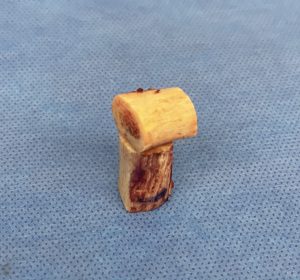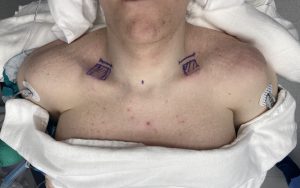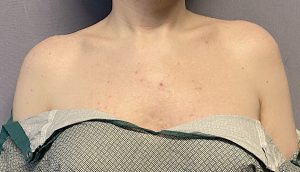Background: Removing a segment of the clavicle allows an obvious inward movement of the shoulders with the loss of its bone length. Because it is the collarbone such reduction osteotomies are often thought of as fractures…a well known traumatic bone injury of the clavicle. But understanding how a clavicle osteotomy is different than a fracture explains many aspects of the intraoperative surgical technique and the postoperative recovery of clavicle reduction osteotomies.
A clavicle fracture is rarely a completely transverse line like that done in osteotomy cut. They are often at least oblique in orientation and not uncommonly spiral or even comminuted. As a result they usually have a larger surface area for the bone to heal. This often requires fixation devices that are much longer than those used in clavicle reduction osteotomies….often well over 1/2 the length of the clavicle with an associated longer incision to apply these devices. An important conceptual difference is that surgery in clavicle fractures is designed to bring the bone back out to length in a shoulder that is often injured as well.
Conversely a clavicle osteotomy is a very discrete cross-sectional cut in the bone. This is a smaller area of bone to heal and the plate fixation applied to hold it together has a much shorter length due to the use of a smaller access incision. It is also surgery that is designed to reduce the length of the clavicle on an otherwise normal functioning shoulder.
Case Study: This patient desired to a more feminine shoulder shape with a bideltoid distance of 49cms. There was not much clavicle show indicating that the softy tissues were fairly thick over the clavicles. There was some asymmetry with the left clavicle being longer with a higher left shoulder.




Case Highlights:
1) Segmental clavicle resection is an effective shoulder reduction procedure.
2) The key to a successful shoulder reduction is stable fixation of the reapposed medial and lateral bone segments across a narrow osteotomy site.
3) Clavicle reduction plate fixation can not be very long in length to keep the incision small, thus the need for double plating.
Dr. Barry Eppley
World-Renowned Plastic Surgeon






